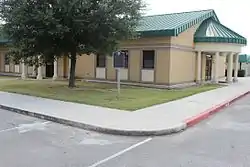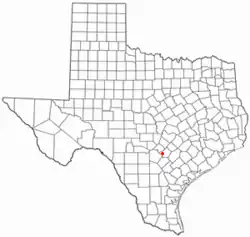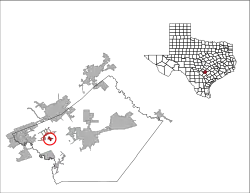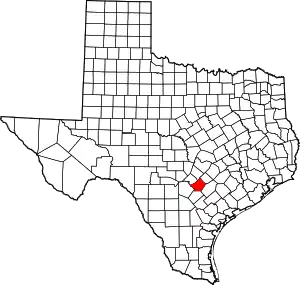Marion, Texas | |
|---|---|
 Marion public library | |
 Location of Marion, Texas | |
 | |
| Coordinates: 29°34′19″N 98°8′21″W / 29.57194°N 98.13917°W | |
| Country | United States |
| State | Texas |
| County | Guadalupe |
| Area | |
| • Total | 0.78 sq mi (2.02 km2) |
| • Land | 0.78 sq mi (2.02 km2) |
| • Water | 0.00 sq mi (0.00 km2) |
| Elevation | 646 ft (197 m) |
| Population (2020) | |
| • Total | 1,034 |
| • Density | 1,588.99/sq mi (613.50/km2) |
| Time zone | UTC-6 (Central (CST)) |
| • Summer (DST) | UTC-5 (CDT) |
| ZIP code | 78124 |
| Area code | 830 |
| FIPS code | 48-46692[2] |
| GNIS feature ID | 1340958[3] |
| Website | cityofmariontx |
Marion is a city in Guadalupe County, Texas, United States. The town was incorporated by 1941. The population was 1,034 at the 2020 census.[4] It is part of the San Antonio Metropolitan Statistical Area.
History
The town is named after Marion Dove, whose grandfather, Joshua W. Young, owned a plantation that the Galveston, Harrisburg and San Antonio Railway passed through in 1877.[5]
Geography
Farm to Market Road 78 passes through the center of town, leading west 26 miles (42 km) to San Antonio and east 12 miles (19 km) to Seguin, the Guadalupe County seat.
According to the United States Census Bureau, Marion has a total area of 0.77 square miles (2.0 km2), all land.[4]
Marion is a small town that has a 3A school (mascot is the Marion Bulldogs) and a few businesses, including a hardware store, meat market, gas stations and several restaurants.
Demographics
| Census | Pop. | Note | %± |
|---|---|---|---|
| 1880 | 90 | — | |
| 1940 | 373 | — | |
| 1950 | 439 | 17.7% | |
| 1960 | 557 | 26.9% | |
| 1970 | 655 | 17.6% | |
| 1980 | 674 | 2.9% | |
| 1990 | 984 | 46.0% | |
| 2000 | 1,099 | 11.7% | |
| 2010 | 1,066 | −3.0% | |
| 2020 | 1,034 | −3.0% | |
| U.S. Decennial Census[6] | |||
| Race | Number | Percentage |
|---|---|---|
| White (NH) | 474 | 45.84% |
| Black or African American (NH) | 53 | 5.13% |
| Asian (NH) | 4 | 0.39% |
| Pacific Islander (NH) | 1 | 0.1% |
| Mixed/Multi-Racial (NH) | 21 | 2.03% |
| Hispanic or Latino | 481 | 46.52% |
| Total | 1,034 |
As of the 2020 United States census, there were 1,034 people, 386 households, and 255 families residing in the city.
As of the census[2] of 2000, there were 1,099 people in the city. The population density was 1,544.0 inhabitants per square mile (596.1/km2). There were 393 housing units at an average density of 561.4 per square mile (216.8/km2). The racial makeup of the city was 74.25% White, 6.01% African American, 1.09% Native American, 1.09% Asian, 16.01% from other races, and 1.55% from two or more races. Hispanic or Latino of any race were 37.22% of the population.
There were 393 households, out of which 43.7% had children under the age of 18 living with them, 59.6% were married couples living together, 18.1% had a female householder with no husband present, and 19.4% were non-families. 17.5% of all households were made up of individuals, and 6.7% had someone living alone who was 65 years of age or older. The average household size was 2.95 and the average family size was 3.32 which can be directly compared to the US's average household size of 2.59 and average family size of 3.14.
In the city, the population was spread out, with 30.9% under the age of 18, 7.8% from 18 to 24, 29.8% from 25 to 44, 20.4% from 45 to 64, and 11.1% who were 65 years of age or older. The median age was 34 years. For every 100 females, there were 96.3 males. For every 100 females age 18 and over, there were 84.7 males.
The median income for a household in the city was $36,635, and the median income for a family was $40,625. Males had a median income of $27,125 versus $21,771 for females. The per capita income for the city was $13,302. About 7.0% of families and 8.4% of the population were below the poverty line, including 9.7% of those under age 18 and 13.8% of those age 65 or over.
Education
The city is served by the Marion Independent School District. A small portion is served by the Schertz-Cibolo-Universal City Independent School District.
References
- ↑ "2019 U.S. Gazetteer Files". United States Census Bureau. Retrieved August 7, 2020.
- 1 2 "U.S. Census website". United States Census Bureau. Retrieved January 31, 2008.
- ↑ "US Board on Geographic Names". United States Geological Survey. October 25, 2007. Retrieved January 31, 2008.
- 1 2 "Geographic Identifiers: 2010 Demographic Profile Data (G001): Marion city, Texas". U.S. Census Bureau, American Factfinder. Retrieved March 24, 2017.
- ↑ Vivian Elizabeth Smyrl. "MARION, TEXAS". Handbook of Texas Online. Retrieved May 26, 2010.
- ↑ "Census of Population and Housing". Census.gov. Retrieved June 4, 2015.
- ↑ "Explore Census Data". data.census.gov. Retrieved May 24, 2022.
- ↑ https://www.census.gov/
- ↑ "About the Hispanic Population and its Origin". www.census.gov. Retrieved May 18, 2022.
